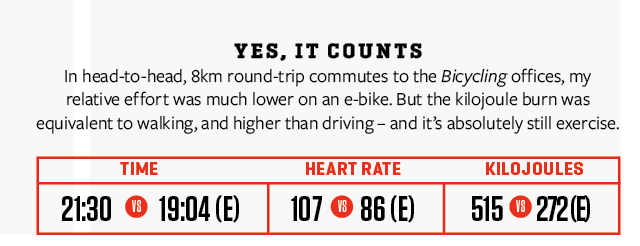What E-Bikes Mean For Your Hard-Won Fitness
Does new pedal assist technology diminish your years of hard work? We dig in to find out.
E-bikes are here to stay. Not everyone is happy about that. I used to be one of those people.
Why? Because of a nagging, if irrational, concern that e-bikes somehow diminish the currency of my fitness and hard work as a trainer, coach, and athlete.
I mean, do you know how long it takes to improve your power just 20 or 30 watts? A full year. Sure, I’ve seen a few total newbies gain 100 watts over 12 months of serious training. But that’s rare.
According to Hunter Allen of TrainingPeaks, who tracks this stuff for a living, if you’re already pretty fit, you have to work super-hard for at least eight weeks to gain another 15 to 30 watts – about the amount needed to power an oven light. And even then, you can’t hang onto that peak forever. The currency of cycling fitness is hard to earn, and easy to lose.
So whether we win a podium position, a pixellated KOM crown, or a drag race with friends to the coffee bar, we cyclists feel extra satisfied – maybe even vindicated – because getting that result took so much dedication.
RELATED: FIRST LOOK: Specialized’s New 2019 Levo
E-bikes let people achieve a far faster pace with far less fitness and hard work. And while I’m all for getting more people on bikes however that happens, I can’t lie: if you push a button and drop me on an 8-per-cent grade that I put in 12 hours of training a week for 10 years to be able to ride as fast as I do… well, it feels a little like I scrimped and saved for a dream holiday only to have my money plummet in value as soon as I get to the swim-up bar counter. Which is crowded with hedonistic trustfunders waving around their own inflated currency.
I know this makes little sense. Nothing changes the fact that I sacrificed and worked damn hard for my fitness. There’s an intrinsic value there that has nothing to do with other people. Yet I can’t help wondering if someday those of us who favour acoustic bikes will be like modern fixie or single-speed riders, always needing to explain (even to ourselves) that we were only beaten because the riders around us were using the latest technology. Will that degrade the sublimity of that 100-per-cent
empty, endorphin-flooded place (a place I’ve tried hard to find on e-bikes, by the way) that you get when your only throttling is internal? I sincerely hope not. But I don’t know. In fact, nobody does.
It’s something we’re all trying to figure out as we ride e-bikes, and ride among them.
I’m not anti e-bike or even anti e-bike racing, which the UCI now sanctions. For people who want or need less Zone 5, just don’t want to sweat on the way to work, physically couldn’t ride without an assist, or simply want maximum joywatts per pedal stroke, e-bikes are a legitimate answer.
RELATED: 13 Reasons To Get Stoked About E-Bikes
And, as a trainer, I recognize that for general health and wellness, every bit counts. In one study, when otherwise inactive people were given e-bikes and told to ride a minimum of 40 minutes a day three days a week for a month, they willingly rode beyond the minimum, boosted their fitness, improved their blood sugar, trimmed some fat, and oh, yeah, had a blast. Nobody’s fitness was devalued in that experiment!
In fact, I want to ride e-bikes more. I dream of a day when drop-bar e-bikes get so light and capable of long ranges that I’ll be able to cover 300km in a day – half on pure human power and half with pedal assist, exploring far-flung roads.
There’s clearly room in the cycling world – and in my own life – for e-bikes. I just need to keep making room for them in my own internal system of valuing my fitness. We all do.


